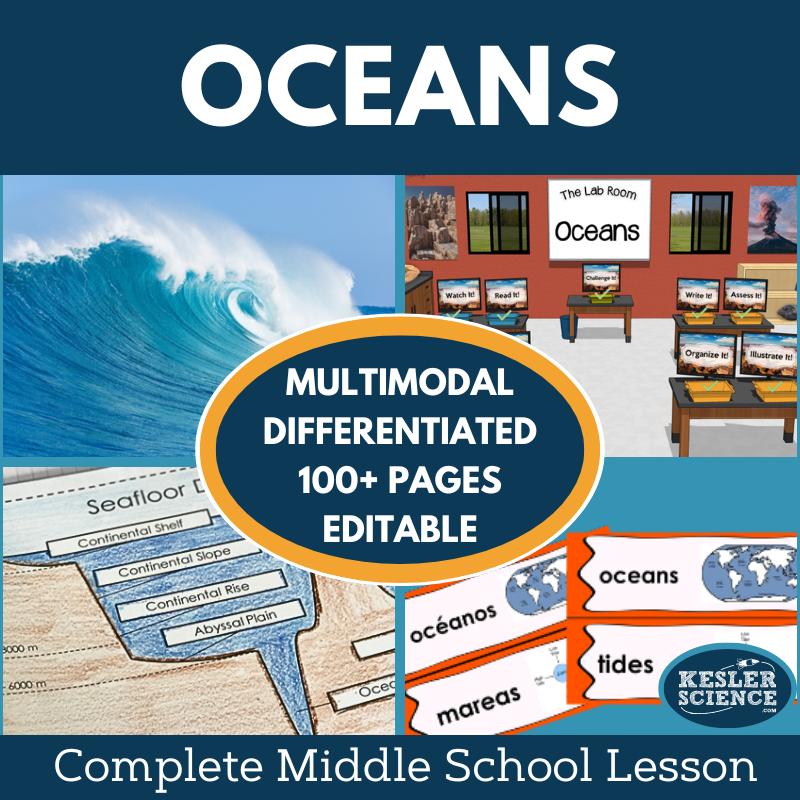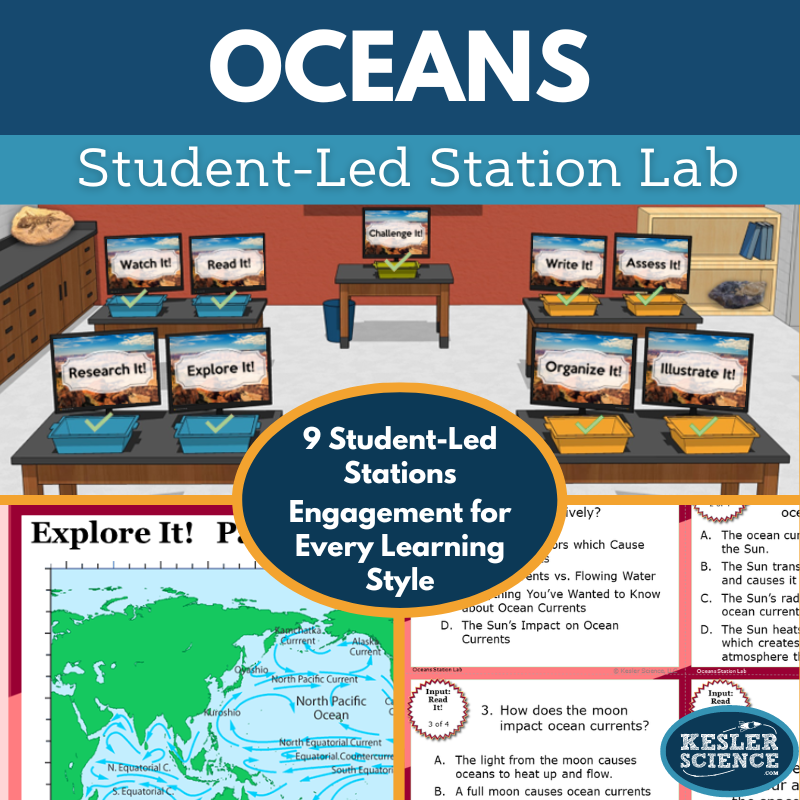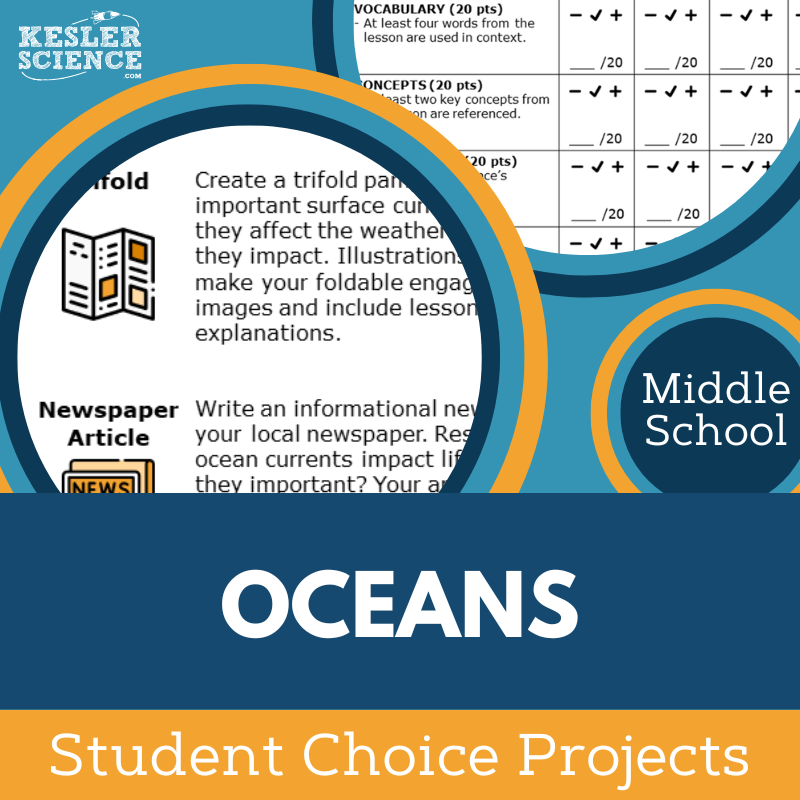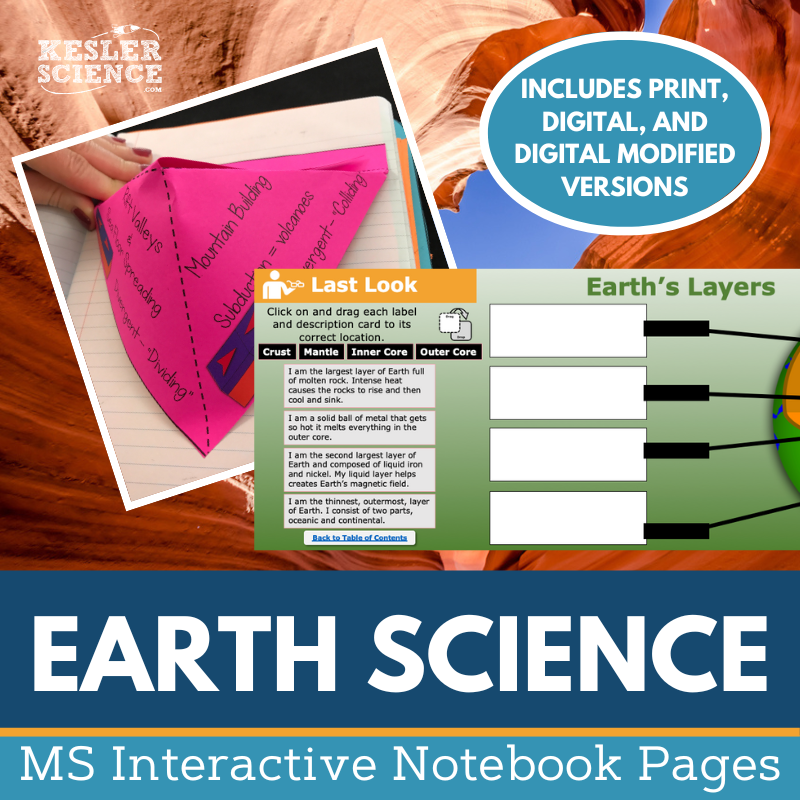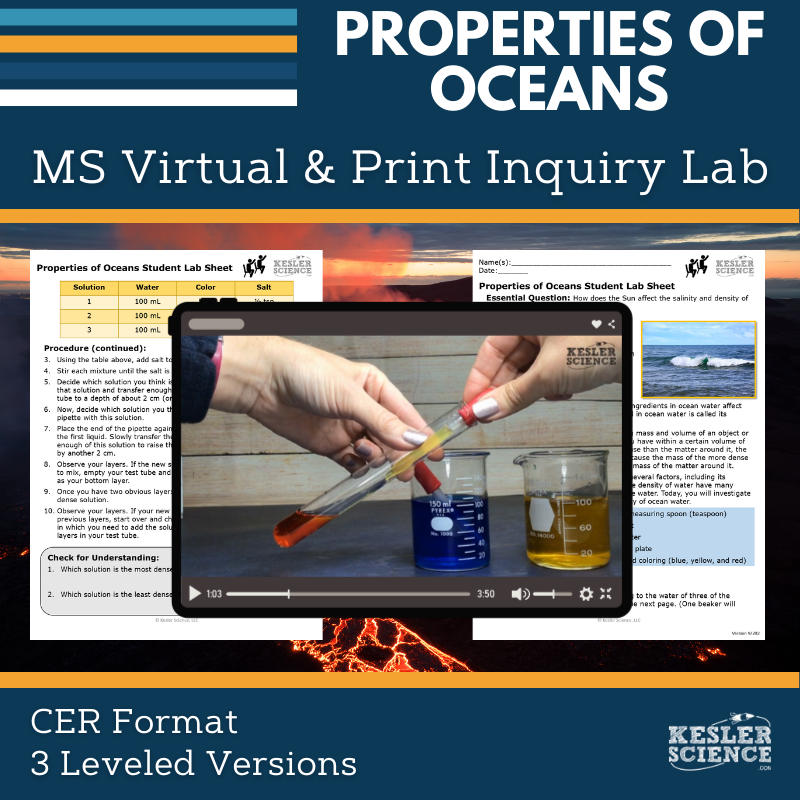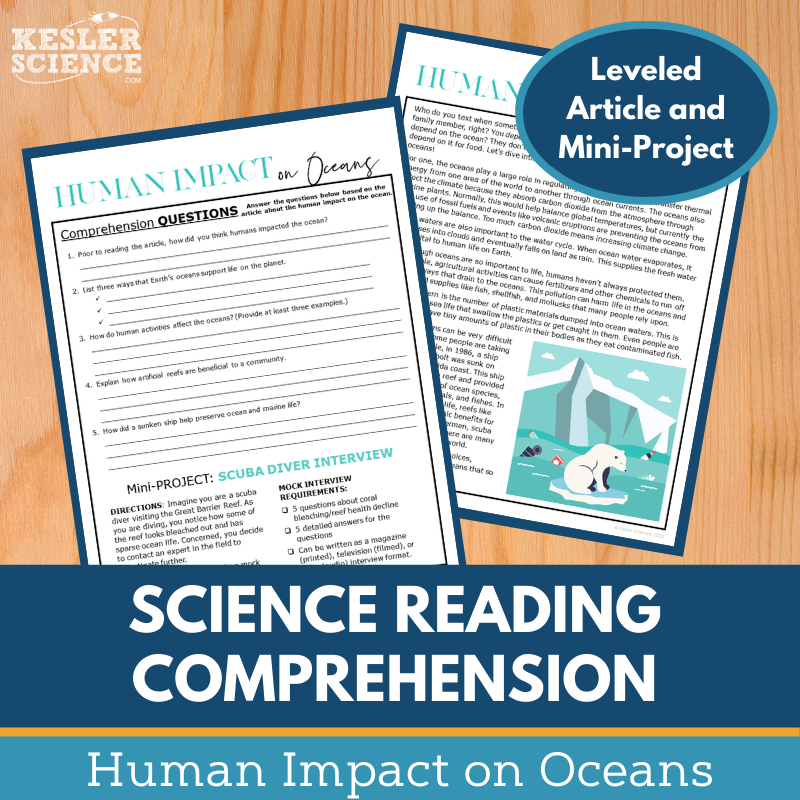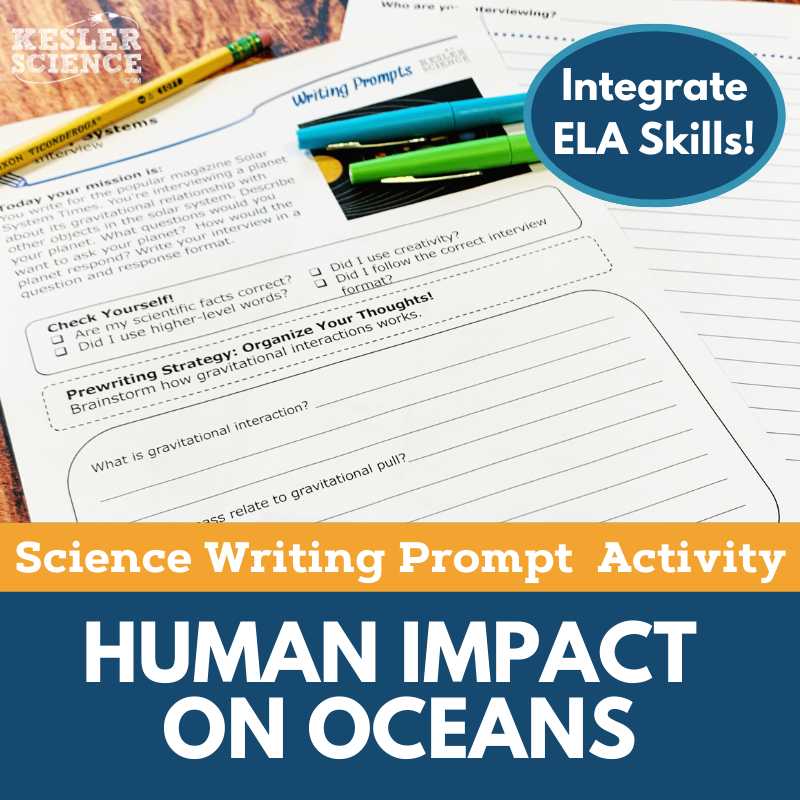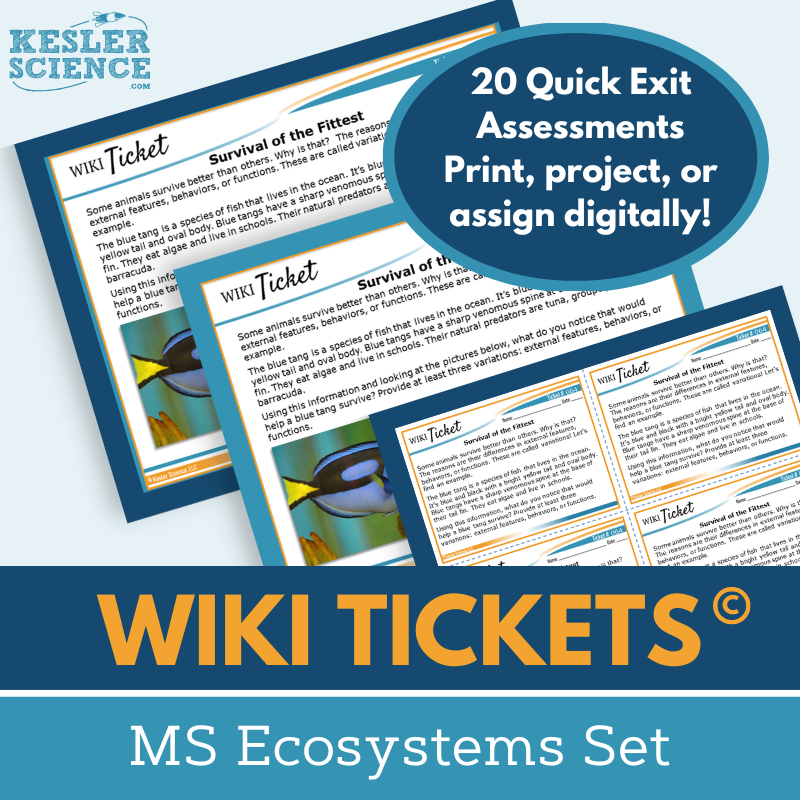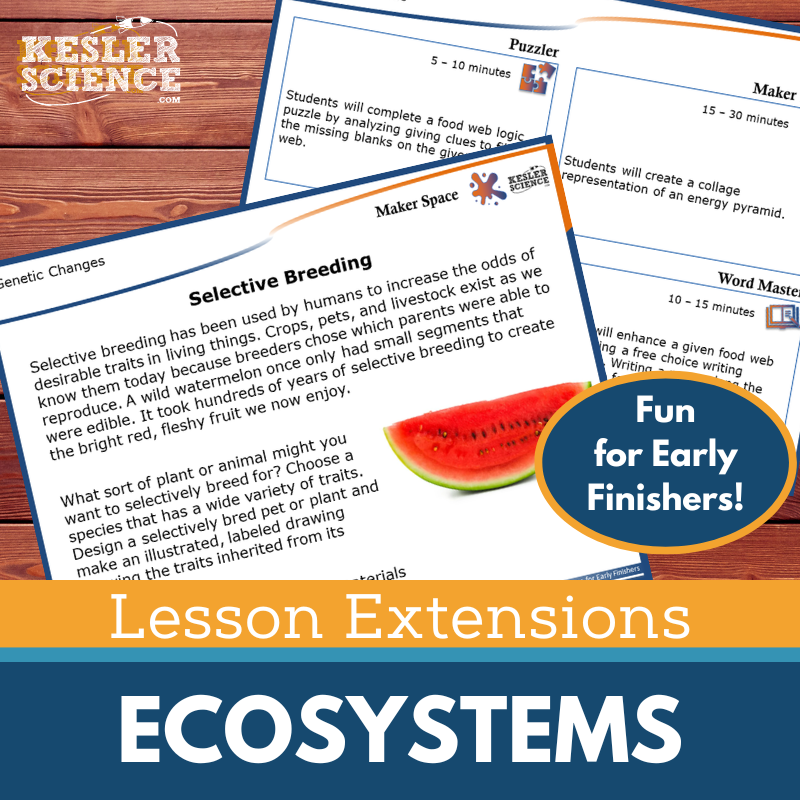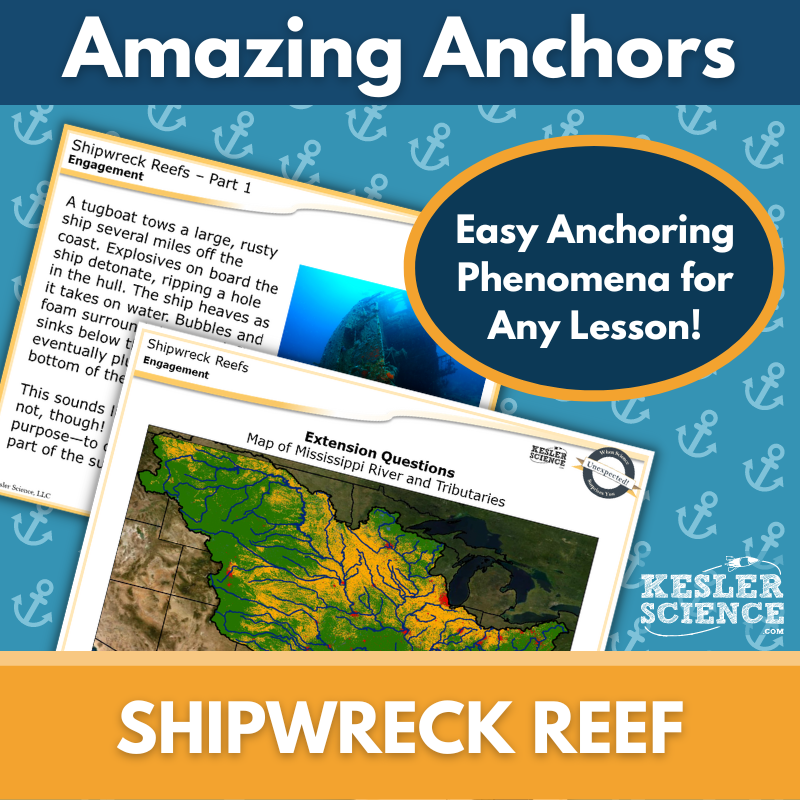Oceans Activities for Middle School Science
The Kesler Science Oceans resources offer a comprehensive, flexible curriculum for middle school students to explore the complexities of ocean science. The resources below will give students a comprehensive understanding of Earth's oceans. All of the following materials are also included in the Kesler Science Membership.
Make lesson planning a breeze with the Kesler Science Oceans Complete 5E Lesson for 6th, 7th, and 8th grade! This resource offers a multi-day, student-centered approach with minimal prep. Cover essential topics like salinity, ocean currents, seafloor mapping, and human impact on the oceans with differentiated materials, multimodal learning, and maximum flexibility in formats—printable or digital.
Aligned with the 5E Model (Engagement, Exploration, Explanation, Elaboration, Evaluation), the lesson includes interactive station labs, editable PowerPoints, and student-choice projects to cater to diverse learning styles. Students will engage with hands-on experiments, reading passages in English and Spanish, research tasks, and videos. The flexible content includes differentiated levels for all students and an extension challenge for advanced learners.
Ideal for in-person or virtual learning, the lesson features Spanish translations, editable resources, and standards-aligned assessment materials. It’s a dynamic and comprehensive solution that promotes critical thinking, engagement, and mastery of ocean science concepts.
Make lesson planning a breeze with the Kesler Science Oceans Complete 5E Lesson for 6th, 7th, and 8th grade! This resource offers a multi-day, student-centered approach with minimal prep. Cover essential topics like salinity, ocean currents, seafloor mapping, and human impact on the oceans with differentiated materials, multimodal learning, and maximum flexibility in formats—printable or digital.
Aligned with the 5E Model (Engagement, Exploration, Explanation, Elaboration, Evaluation), the lesson includes interactive station labs, editable PowerPoints, and student-choice projects to cater to diverse learning styles. Students will engage with hands-on experiments, reading passages in English and Spanish, research tasks, and videos. The flexible content includes differentiated levels for all students and an extension challenge for advanced learners.
Ideal for in-person or virtual learning, the lesson features Spanish translations, editable resources, and standards-aligned assessment materials. It’s a dynamic and comprehensive solution that promotes critical thinking, engagement, and mastery of ocean science concepts.
Keep your middle schoolers engaged with this modular, student-led ocean activity, a comprehensive earth science lesson designed to explore human dependence on ocean systems and the impact of human activities. This resource offers a differentiated, student-centered approach that encourages independent learning, saves prep time, and fosters curiosity.
Featuring nine modular stations, the lab includes hands-on, research-based, and creative tasks. Input stations like "Explore It!" and "Watch It!" introduce concepts through experiments and videos, while Output stations like "Illustrate It!" and "Write It!" allow students to demonstrate their understanding. A bonus "Challenge It!" station extends learning for early finishers with games, crosswords, and mini-projects.
With all materials—signage, task cards, and differentiated texts in English and Spanish—ready for print or digital use, this resource is ideal for in-person or virtual classrooms. Engage your students in meaningful exploration of ocean science while promoting critical thinking and personalized learning!
Keep your middle schoolers engaged with this modular, student-led ocean activity, a comprehensive earth science lesson designed to explore human dependence on ocean systems and the impact of human activities. This resource offers a differentiated, student-centered approach that encourages independent learning, saves prep time, and fosters curiosity.
Featuring nine modular stations, the lab includes hands-on, research-based, and creative tasks. Input stations like "Explore It!" and "Watch It!" introduce concepts through experiments and videos, while Output stations like "Illustrate It!" and "Write It!" allow students to demonstrate their understanding. A bonus "Challenge It!" station extends learning for early finishers with games, crosswords, and mini-projects.
With all materials—signage, task cards, and differentiated texts in English and Spanish—ready for print or digital use, this resource is ideal for in-person or virtual classrooms. Engage your students in meaningful exploration of ocean science while promoting critical thinking and personalized learning!
Empower your middle school students with the Kesler Science Oceans Student Choice Projects, where they can select from six creative project options or design their own to demonstrate their understanding of oceanography. With a flexible, student-centered approach, this resource includes a detailed project page, editable rubrics for assessment, and teacher guidance for seamless implementation.
This resource promotes differentiated learning with two versions of the project page. The modified version offers tailored options for students requiring additional support, while advanced learners can take on multiple projects. The editable rubric assesses key skills like vocabulary, concepts, presentation, clarity, and accuracy, providing flexibility for various grading needs.
Designed for accessibility, these projects utilize standard classroom supplies, with options for digital or hands-on completion. Whether building models or crafting presentations, students will engage in a meaningful exploration of ocean science while developing creativity and critical thinking skills.
Empower your middle school students with the Kesler Science Oceans Student Choice Projects, where they can select from six creative project options or design their own to demonstrate their understanding of oceanography. With a flexible, student-centered approach, this resource includes a detailed project page, editable rubrics for assessment, and teacher guidance for seamless implementation.
This resource promotes differentiated learning with two versions of the project page. The modified version offers tailored options for students requiring additional support, while advanced learners can take on multiple projects. The editable rubric assesses key skills like vocabulary, concepts, presentation, clarity, and accuracy, providing flexibility for various grading needs.
Designed for accessibility, these projects utilize standard classroom supplies, with options for digital or hands-on completion. Whether building models or crafting presentations, students will engage in a meaningful exploration of ocean science while developing creativity and critical thinking skills.
The Kesler Science Earth Science Interactive Notebook Bundle is a must-have for teachers who want to provide an interactive learning experience in earth science. It includes both print and digital versions, making it a versatile resource for traditional classrooms, 1:1 environments, and distance learning.
The bundle covers a wide range of earth science topics, including Continental Drift Theory, plate boundaries, rocks and minerals, the rock cycle, Earth’s layers, volcanoes, earthquakes, and more. It also features activities like Venn diagrams, topographic maps, and reflection pages to help students demonstrate understanding and make connections between concepts.
The digital version includes a unique interactive notebook PowerPoint, which can be uploaded to Google Slides or learning management systems like MS Teams and Canvas. The paper version provides blank and pre-filled templates, along with color photos to guide students in completing each activity. Both versions come with a teacher answer key and a modified version for students with accommodations.
The Kesler Science Earth Science Interactive Notebook Bundle is a must-have for teachers who want to provide an interactive learning experience in earth science. It includes both print and digital versions, making it a versatile resource for traditional classrooms, 1:1 environments, and distance learning.
The bundle covers a wide range of earth science topics, including Continental Drift Theory, plate boundaries, rocks and minerals, the rock cycle, Earth’s layers, volcanoes, earthquakes, and more. It also features activities like Venn diagrams, topographic maps, and reflection pages to help students demonstrate understanding and make connections between concepts.
The digital version includes a unique interactive notebook PowerPoint, which can be uploaded to Google Slides or learning management systems like MS Teams and Canvas. The paper version provides blank and pre-filled templates, along with color photos to guide students in completing each activity. Both versions come with a teacher answer key and a modified version for students with accommodations.
The Properties of Oceans Inquiry Lab helps students investigate how solar energy affects ocean salinity and density. Students conduct an experiment by layering salt water solutions of different concentrations and observing changes when heat causes evaporation. This lab supports NGSS-aligned learning by prompting students to model real-world ocean processes and draw conclusions based on evidence.
Three differentiated versions—dependent, modified, and independent—are included for both digital and print formats, allowing teachers to match instruction to varied student needs. All versions come with comprehension checks, Claim-Evidence-Reasoning (C.E.R.) prompts, and a reflection section to deepen understanding. The digital format requires no materials, while the hands-on version uses common classroom supplies like salt, pipettes, food coloring, and a hot plate.
Editable PowerPoints, Google Slides compatibility, and detailed teacher resource pages make this lab flexible and easy to implement. With built-in supports and varying levels of guidance, the Salinity and Density Lab delivers an engaging experience that meets the needs of diverse learners.
The Properties of Oceans Inquiry Lab helps students investigate how solar energy affects ocean salinity and density. Students conduct an experiment by layering salt water solutions of different concentrations and observing changes when heat causes evaporation. This lab supports NGSS-aligned learning by prompting students to model real-world ocean processes and draw conclusions based on evidence.
Three differentiated versions—dependent, modified, and independent—are included for both digital and print formats, allowing teachers to match instruction to varied student needs. All versions come with comprehension checks, Claim-Evidence-Reasoning (C.E.R.) prompts, and a reflection section to deepen understanding. The digital format requires no materials, while the hands-on version uses common classroom supplies like salt, pipettes, food coloring, and a hot plate.
Editable PowerPoints, Google Slides compatibility, and detailed teacher resource pages make this lab flexible and easy to implement. With built-in supports and varying levels of guidance, the Salinity and Density Lab delivers an engaging experience that meets the needs of diverse learners.
This Human Impact on the Ocean Science Reading Comprehension Lesson helps middle school students explore how human activities such as runoff, artificial reefs, and resource use have affected ocean systems. Through a nonfiction article focused on the Great Barrier Reef, students learn about the relationship between human dependence and environmental change. They then complete comprehension questions and a creative mini-project by crafting a mock interview with a dive master or ocean life expert.
The resource includes two leveled passages (Lexile 1100–1300), five to seven comprehension questions, and a hands-on activity. A Cornell notes template and engaging visuals are provided, and all materials are suitable for printing in grayscale. The content supports reading comprehension and science literacy for grades 6–8, with adaptations possible for advanced 5th grade readers.
Designed for both in-class and virtual learning, the files are compatible with platforms like Google Classroom and Schoology. Students can complete the work digitally or on paper, making this resource ideal for absent students, sub plans, or enrichment. It encourages classroom discussion and supports science reading routines across a unit or topic.
This Human Impact on the Ocean Science Reading Comprehension Lesson helps middle school students explore how human activities such as runoff, artificial reefs, and resource use have affected ocean systems. Through a nonfiction article focused on the Great Barrier Reef, students learn about the relationship between human dependence and environmental change. They then complete comprehension questions and a creative mini-project by crafting a mock interview with a dive master or ocean life expert.
The resource includes two leveled passages (Lexile 1100–1300), five to seven comprehension questions, and a hands-on activity. A Cornell notes template and engaging visuals are provided, and all materials are suitable for printing in grayscale. The content supports reading comprehension and science literacy for grades 6–8, with adaptations possible for advanced 5th grade readers.
Designed for both in-class and virtual learning, the files are compatible with platforms like Google Classroom and Schoology. Students can complete the work digitally or on paper, making this resource ideal for absent students, sub plans, or enrichment. It encourages classroom discussion and supports science reading routines across a unit or topic.
The Human Impact on Oceans science writing activity invites middle school students to creatively demonstrate their earth science knowledge through an invention design writing prompt. Using a low-prep, student-centered approach, this activity encourages science reasoning, written communication, and critical thinking in both print and digital formats. The resource supports virtual learning and is ideal for engaging students inside or outside the classroom.
Aligned with TEKS and NGSS standards, the prompt can be used as a review or elaboration tool alongside other Kesler Science products. The lesson includes teacher directions, project ideas, and assessment rubrics. Both full-size and half-sheet handouts offer writing prompts, self-check tools, prewriting strategies, and layout templates, while a digital version is included for remote instruction via PowerPoint or Google Slides.
This versatile activity is suitable for a range of classroom needs, including cross-curricular writing, pre-test assessments, enrichment for early finishers, extra credit, or differentiated instruction. Students can showcase their work on bulletin boards or compile it into personal anthologies, making it a flexible and engaging addition to any middle school science classroom.
The Human Impact on Oceans science writing activity invites middle school students to creatively demonstrate their earth science knowledge through an invention design writing prompt. Using a low-prep, student-centered approach, this activity encourages science reasoning, written communication, and critical thinking in both print and digital formats. The resource supports virtual learning and is ideal for engaging students inside or outside the classroom.
Aligned with TEKS and NGSS standards, the prompt can be used as a review or elaboration tool alongside other Kesler Science products. The lesson includes teacher directions, project ideas, and assessment rubrics. Both full-size and half-sheet handouts offer writing prompts, self-check tools, prewriting strategies, and layout templates, while a digital version is included for remote instruction via PowerPoint or Google Slides.
This versatile activity is suitable for a range of classroom needs, including cross-curricular writing, pre-test assessments, enrichment for early finishers, extra credit, or differentiated instruction. Students can showcase their work on bulletin boards or compile it into personal anthologies, making it a flexible and engaging addition to any middle school science classroom.
The WIKI Tickets© Formative Assessments offer engaging and flexible ways to assess middle school students’ understanding of key science concepts. This Ecosystems Set includes 20 topics, each available in five different formats: a full-screen version for projection, three handout versions (full, split, and quarter-page), and an interactive digital version compatible with PowerPoint and Google Slides. These assessments are designed for grades 6–8 and can be used as exit tickets, bellringers, or quick formative checks.
All materials are aligned with NGSS and TEKS standards, and each set includes a table of contents showing the standard alignment. Topics covered include biodiversity, biotic and abiotic factors, energy flow, food webs, natural selection, ecological succession, human impact on oceans, and more. Some standards include multiple tickets to reinforce key concepts and support differentiated instruction.
WIKI Tickets© are designed for use in both in-person and virtual classrooms. Teachers can project the assessments or print them out for classroom use, while students in 1:1 or remote environments can complete their responses digitally. With vibrant design and a student-centered format, these assessments provide a consistent, low-prep way to gauge student progress throughout your ecosystems unit.
The WIKI Tickets© Formative Assessments offer engaging and flexible ways to assess middle school students’ understanding of key science concepts. This Ecosystems Set includes 20 topics, each available in five different formats: a full-screen version for projection, three handout versions (full, split, and quarter-page), and an interactive digital version compatible with PowerPoint and Google Slides. These assessments are designed for grades 6–8 and can be used as exit tickets, bellringers, or quick formative checks.
All materials are aligned with NGSS and TEKS standards, and each set includes a table of contents showing the standard alignment. Topics covered include biodiversity, biotic and abiotic factors, energy flow, food webs, natural selection, ecological succession, human impact on oceans, and more. Some standards include multiple tickets to reinforce key concepts and support differentiated instruction.
WIKI Tickets© are designed for use in both in-person and virtual classrooms. Teachers can project the assessments or print them out for classroom use, while students in 1:1 or remote environments can complete their responses digitally. With vibrant design and a student-centered format, these assessments provide a consistent, low-prep way to gauge student progress throughout your ecosystems unit.
Lesson Extensions provide engaging, student-choice activities designed to challenge early finishers and deepen their understanding of ecosystems. These creative, high-rigor tasks are ideal for lesson wrap-ups, enrichment during testing downtime, or independent work that curbs distractions. Each activity aligns with NGSS and TEKS standards, offering students opportunities to explore ecosystems through meaningful, standards-based learning.
Each Lesson Extension includes four components to promote a variety of skills: Puzzler for problem-solving, Maker Space for hands-on STEAM exploration, Tech Connection for digital demonstration of learning, and Word Master for incorporating creative writing. Materials come with teacher directions, answer keys, projection-friendly versions, and printable full- and half-sheet handouts to suit different classroom needs.
Covering over 25 ecosystem-related topics—such as biodiversity, food webs, ecological succession, humans and ocean systems, and environmental changes—these resources support independent learners by scaffolding critical thinking, creativity, and content mastery. Lesson Extensions are flexible tools that help students extend their learning in fun and productive ways.
Lesson Extensions provide engaging, student-choice activities designed to challenge early finishers and deepen their understanding of ecosystems. These creative, high-rigor tasks are ideal for lesson wrap-ups, enrichment during testing downtime, or independent work that curbs distractions. Each activity aligns with NGSS and TEKS standards, offering students opportunities to explore ecosystems through meaningful, standards-based learning.
Each Lesson Extension includes four components to promote a variety of skills: Puzzler for problem-solving, Maker Space for hands-on STEAM exploration, Tech Connection for digital demonstration of learning, and Word Master for incorporating creative writing. Materials come with teacher directions, answer keys, projection-friendly versions, and printable full- and half-sheet handouts to suit different classroom needs.
Covering over 25 ecosystem-related topics—such as biodiversity, food webs, ecological succession, humans and ocean systems, and environmental changes—these resources support independent learners by scaffolding critical thinking, creativity, and content mastery. Lesson Extensions are flexible tools that help students extend their learning in fun and productive ways.
This Amazing Anchors Phenomenon Lesson introduces and reinforces the concept of ocean ecosystems through real-world connections. It begins with an introductory reading centered on artificial reefs, paired with comprehension and extension questions to build curiosity and background knowledge. A second, explanatory reading dives deeper into the science of ocean ecosystems, followed by additional questions that help students make connections and extend their learning.
The resource includes teacher directions with answer keys, editable materials, and versions for projection, print, and digital use. Full- and half-sheet handouts support flexible classroom formats and are ideal for interactive notebooks or digital learning management systems. The lesson is TEKS-aligned and designed to be used as a supplement that bookends your core instruction.
Differentiated options are available to support all learners, including a modified version with sentence starters and simplified language for comprehension support. Whether teaching in person or virtually, this resource is a valuable tool for engaging students in the Engagement and Elaborate phases of the 5E instructional model.
This Amazing Anchors Phenomenon Lesson introduces and reinforces the concept of ocean ecosystems through real-world connections. It begins with an introductory reading centered on artificial reefs, paired with comprehension and extension questions to build curiosity and background knowledge. A second, explanatory reading dives deeper into the science of ocean ecosystems, followed by additional questions that help students make connections and extend their learning.
The resource includes teacher directions with answer keys, editable materials, and versions for projection, print, and digital use. Full- and half-sheet handouts support flexible classroom formats and are ideal for interactive notebooks or digital learning management systems. The lesson is TEKS-aligned and designed to be used as a supplement that bookends your core instruction.
Differentiated options are available to support all learners, including a modified version with sentence starters and simplified language for comprehension support. Whether teaching in person or virtually, this resource is a valuable tool for engaging students in the Engagement and Elaborate phases of the 5E instructional model.
Year-Round Resources
These year-round activities will increase your students' understanding of many middle school science topics. All of these activities are also included in the Kesler Science Membership.
Visual Data & Graphing
You're not alone if your students struggle with understanding graphs, charts, and tables. It's a skill that takes an enormous amount of practice. This resource will help students build a strong foundation in analyzing data and creating their own data visualizations.
Bell Ringers and Warm-Ups
These middle school science bell ringers are an excellent way to engage your students as soon as they walk into your classroom. This comprehensive FULL YEAR resource includes everything you need to start off each science class with an interesting warm-up activity.
Review Board Games
Each game board has been carefully designed to keep students engaged. There are 10 different action spaces on each board and dozens of question cards. All of the actions are related to science concepts and keep the students motivated throughout the game.
Each game is ready to play. Simply print out the board and the cards and let the students enjoy reviewing nine different units.
Essential Questions
Below are the essential questions associated with the lessons and activities included in this unit. This topic is only one of more than 100 middle school science topics included in the Kesler Science Membership.
-
What elements make up the ocean?
-
How are salinity, temperature, and density related?
-
How does the sun drive ocean currents?
-
What are some examples of seafloor structures and how are they mapped?
-
How are humans dependent on oceans?
-
How have human activities modified the oceans?
Kesler Science Membership
Imagine never having to search for another middle school science lesson again. The membership gives you access to ALL of the Kesler Science products in one place (Yes, including everything above).
Say goodbye to long hours of lesson prep.

